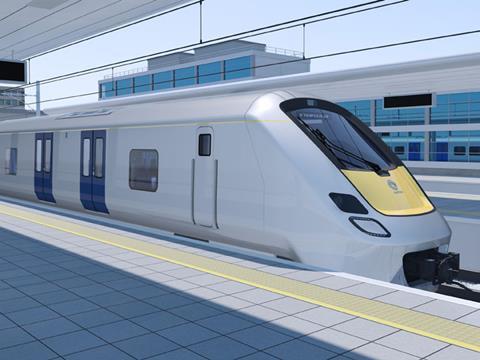
UK: Alstom formally presented X’trapolis UK, its contender for the Thameslink electric multiple-unit contract, on September 15. Alongside Bombardier and Siemens, Alstom had submitted its bid to the Department for Transport on June 25.
An exhibition accompanying the presentation included models of the train plus a full-size mockup of the 800 mm wide gangway between the cars. The presentation was attended by representatives of DfT Rail, Network Rail and potential operators and owners.
Although targeted at Thameslink and Crossrail, Alstom also sees the X’trapolis UK as its product for the long-term replacement of ex-British Rail EMUs. The design is available in a range of set lengths from 65 m, the equivalent of a current three-car EMU, to 15-car, 240 m long units for Thameslink.
To date Alstom has received orders for over 950 X’trapolis cars. The UK version is, in part, a response to the outline for a New Generation EMU in DfT’s Rail Technical Strategy. According to Alstom Project Director Piers Wood, the new train has a ‘radically different architecture’ compared with the other Thameslink bids, the Bombardier Aventra and Siemens Desiro City.
Unlike these other new-generation EMUs, the X’trapolis is articulated. A 240 m long Aventra or Desiro would have 12 cars, each 20 m long and riding on two bogies. For the same set length the X’trapolis would have 15 shorter vehicles, and what Alstom terms ‘Bogie Offset Articulation’, whereby the bogie is mounted beneath one vehicle end with the adjacent vehicle end supported by a cantilevered frame. With conventional articulation, as on Eurostar, both vehicle ends sit on a central bogie.
Articulation allows shorter and wider vehicles. Alstom claims that the 15·6 m long X’trapolis car is 50 mm wider than an equivalent 20 m long bogie vehicle. Because the coaches are permanently connected, safety crumple zones in the intermediate vehicle ends are eliminated, further increasing usable interior floor space.
Alstom is planning to further capitalise on width by fitting plug doors as these do not require space in the vehicle side like pocketed sliding doors. Another benefit is a reduction in the stepping distance on curved platforms.
With two doors per side and 15 vehicles, a 240 m long X’trapolis set would offer 30 doors compared with 24 for a conventional 12-car train. This is an important consideration at stations in the Thameslink central core where the requirement is for a total of 1 000 passengers to board or alight during a 45 sec dwell time, in order to maintain a peak service frequency of 24 trains/h.
Also aimed at maximising passenger flow is the positioning of the doors close together in the centre of the X’trapolis car. Between the doors is a vestibule area with longitudinal seating. Most EMUs in the UK have doors spaced at one third and two thirds of the car length.
Fewer bogies mean a lighter train. On the basis of figures supplied by the respective manufacturers, a 240 m long X’trapolis EMU would be around 40 tonnes lighter than the Siemens Desiro City.
While Wood concedes that ‘it all comes down to the money’, less weight and fewer bogies translate into lower energy consumption and maintenance costs. Alstom is hoping that this, plus its extensive UK rolling stock maintenance expertise, will be reflected in a lower whole-life cost.

















